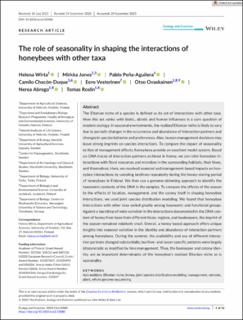| dc.description.abstract | The Eltonian niche of a species is defined as its set of interactions with other taxa. How this set varies with biotic, abiotic and human influences is a core question of modern ecology. In seasonal environments, the realized Eltonian niche is likely to vary due to periodic changes in the occurrence and abundance of interaction partners and changes in species behavior and preferences. Also, human management decisions may leave strong imprints on species interactions. To compare the impact of seasonality to that of management effects, honeybees provide an excellent model system. Based on DNA traces of interaction partners archived in honey, we can infer honeybee interactions with floral resources and microbes in the surrounding habitats, their hives, and themselves. Here, we resolved seasonal and management-based impacts on honeybee interactions by sampling beehives repeatedly during the honey-storing period of honeybees in Finland. We then use a genome-skimming approach to identify the taxonomic contents of the DNA in the samples. To compare the effects of the season to the effects of location, management, and the colony itself in shaping honeybee interactions, we used joint species distribution modeling. We found that honeybee interactions with other taxa varied greatly among taxonomic and functional groups. Against a backdrop of wide variation in the interactions documented in the DNA content of honey from bees from different hives, regions, and beekeepers, the imprint of the season remained relatively small. Overall, a honey-based approach offers unique insights into seasonal variation in the identity and abundance of interaction partners among honeybees. During the summer, the availability and use of different interaction partners changed substantially, but hive- and taxon-specific patterns were largely idiosyncratic as modified by hive management. Thus, the beekeeper and colony identity are as important determinants of the honeybee's realized Eltonian niche as is seasonality. | en_US |

